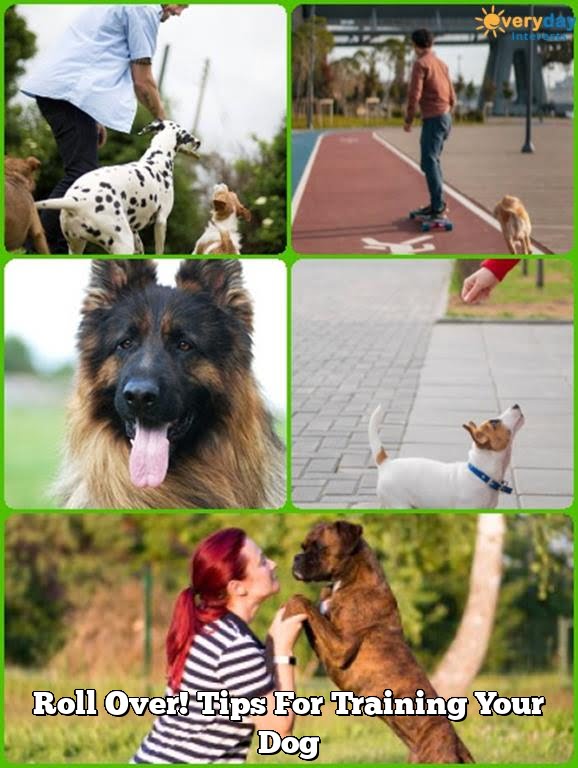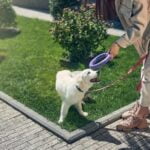Have you ever wondered how to train your dog to roll over? Teaching your furry friend this delightful trick not only showcases their intelligence, but also strengthens the bond between the two of you. In this article, we will delve into the art of dog training and explore the benefits of teaching your canine companion to roll over.
Training your dog to perform tricks is not only a fun activity, but it also provides mental stimulation and physical exercise for your pet. Teaching them to roll over can be a rewarding experience for both you and your furry friend. Not only does it improve their obedience and responsiveness to commands, but it also boosts their confidence and overall well-being.
In this comprehensive guide, we will take you through the step-by-step process of training your dog to roll over. From mastering the basics of lying down on command to using positive reinforcement and incentives, we will provide you with valuable insights and tips to effectively train your pet.
Whether you’re a first-time dog owner or a seasoned trainer, this article will equip you with the knowledge and techniques needed to successfully teach your dog this impressive trick.
The Basics
Teaching your dog how to roll over can be a fun and impressive trick that strengthens the bond between you and your furry friend. However, before you can move on to teaching this advanced command, it’s essential to ensure that your dog has mastered the basics, particularly the “lie down” command. Teaching your dog to lie down on command is a fundamental skill that provides the foundation for more complex tricks like rolling over.
To teach your dog to lie down on command, start by giving the verbal cue “down” while gently guiding your dog into position. You can use a treat to lure your dog into the lying down position, and once they are in the correct posture, reward them with praise and the treat. It’s important to repeat this process consistently until your dog responds to the verbal cue without needing any physical guidance.
Training sessions should be kept short and positive, ensuring that your dog stays engaged and excited about learning. Patience is key when teaching new commands, so it’s crucial not to rush through this process.
Keep in mind that all dogs learn at their own pace, so it’s important to be patient and understanding throughout the training process. With time and practice, your dog will learn to lie down on command reliably, setting the stage for more advanced tricks such as rolling over.
Paws Up
Positioning Your Dog
To start teaching your dog to roll over, begin with the basic “lie down” command. Once your dog has mastered this, you can move on to introducing the “roll over” command. Begin by commanding your dog to lie down and then gently guide them onto one side. Use a treat to entice them into rolling onto their back. Be patient and gentle as you guide them through the motion.
Repetition and Practice
Consistent practice is key to teaching your dog how to roll over. Repetition is important, so be prepared to spend some time each day working on this new trick with your furry friend. Using a clear verbal command along with physical guidance will help your dog understand what is expected of them.
Rewarding Progress
As with any training, positive reinforcement is vital in teaching your dog to roll over. Celebrate small victories with treats and praise, and be sure to show patience and encouragement throughout the process. If your dog shows resistance or frustration, take a step back and revisit the basics before moving forward with the roll over command again.
Incentives
One of the most effective ways to encourage your dog to learn new tricks and behaviors is through the use of incentives such as treats and positive reinforcement. When it comes to teaching your dog to roll over, using these methods can be highly beneficial in achieving success. By providing a reward for performing the desired action, you are not only motivating your dog but also strengthening the bond between the two of you.
When utilizing treats as an incentive, it’s important to choose something that your dog finds particularly enticing. Soft, bite-sized treats that can be easily consumed are often preferred, as they can be quickly eaten by your dog without causing significant distraction from the training process. Additionally, consistently rewarding your dog with treats for successfully rolling over will help reinforce the behavior and make them more inclined to repeat it in the future.
Positive reinforcement is another key element in incentivizing your dog’s behavior. This can include verbal praise, physical affection, or any other form of positive interaction that reinforces their successful completion of the roll over command.
By incorporating this approach into their training, you are effectively communicating to your dog that their actions are appreciated and will result in a favorable outcome. This positivity can greatly enhance their motivation and willingness to learn, making the training process more enjoyable for both you and your furry friend.
| Incentive Type | Effectiveness |
|---|---|
| Treats | Highly effective in motivating dogs to perform desired behaviors |
| Positive Reinforcement | Strengthens bond between owner and dog while promoting continued learning |
Patience and Persistence
Teaching your dog to roll over can be a fun and rewarding experience, but it requires patience and persistence. Just like any other training, teaching your dog this trick takes time and consistency. Here are some tips to help you effectively train your dog to roll over.
Be Patient and Positive
It’s important to remember that every dog learns at their own pace, so patience is key. Avoid getting frustrated if your dog doesn’t pick up the trick right away. Instead, stay positive and provide lots of encouragement during the training sessions. Dogs respond well to positive reinforcement, so be sure to shower them with praise and treats when they make progress.
Break It Down
Breaking the roll over command into smaller steps can make it easier for your dog to understand what is expected of them. Start by reinforcing the “lie down” command that was introduced in the previous training stage. Once your dog is consistently responding to the “lie down” cue, you can then begin introducing the rolling motion by gently guiding them with a treat.
Practice Regularly
Consistent practice is vital when teaching your dog new tricks. Set aside regular training sessions each day and keep them short and engaging, so your dog stays focused and interested. By practicing regularly, you will reinforce the behavior and help your dog become more comfortable with rolling over on command.
By following these tips for patience and persistence, you can effectively train your dog to roll over in no time. Remember that every dog is different, so it’s important to be flexible with your approach while staying committed to the process. With dedication and consistency, you’ll soon celebrate success as you watch your furry friend master this impressive trick.
Troubleshooting
Training your dog to roll over can be a fun and rewarding experience, but it’s not without its challenges. Here are some common issues you may encounter when teaching your dog this trick, and how to overcome them:
1. Fear or discomfort: Some dogs may be hesitant to roll onto their backs due to fear or discomfort. To help your dog overcome this, start by teaching them the “down” command and rewarding them for lying down comfortably. Gradually introduce the roll over motion in small steps, using plenty of treats and praise to reassure them.
2. Lack of motivation: If your dog seems uninterested in learning to roll over, it may be due to a lack of motivation. Try using higher value treats or toys as incentives, and make the training sessions more engaging by incorporating playtime and positive reinforcement.
3. Physical limitations: Certain breeds or individual dogs may have difficulty physically performing the roll over motion due to their size or agility. In these cases, you can modify the behavior by teaching them a partial roll or finding alternative tricks that they can easily learn and enjoy.
4. Distractions: Dogs can easily get distracted during training sessions, especially when learning a new behavior. Start training in a quiet environment with minimal distractions, then gradually introduce more stimuli as your dog becomes more proficient. Use verbal cues and hand signals to keep their focus on the task at hand.
By addressing these common challenges with patience and creativity, you can successfully teach your dog to roll over while strengthening your bond through positive training experiences.
Advanced Training
Training your dog to roll over is a fun and impressive trick that can be taken to the next level by adding distractions and reinforcing the behavior in different environments. Once your dog has mastered the roll over command in a familiar setting, it’s important to gradually introduce distractions to ensure that they can perform the trick under various circumstances.
Start by practicing the roll over command in different rooms of your home or in your backyard. As your dog becomes more proficient, gradually introduce mild distractions such as toys or other pets to the environment. Use positive reinforcement, like treats or enthusiastic praise, to encourage your dog to focus and carry out the command despite these new elements.
Once your dog is able to perform the roll over command reliably at home, it’s time to take their training on the road. Practice the trick in different outdoor settings such as parks or sidewalks, gradually increasing the level of distraction as your dog becomes more adept at following commands in unfamiliar environments. This will help solidify their understanding of the behavior and make them more responsive even when there are various distractions present.
Celebrate Success
Training your dog to roll over is no easy feat, but once your furry friend masters this impressive trick, it’s important to celebrate their success and acknowledge their progress. By rewarding your dog for a job well done, you can reinforce the behavior and encourage them to continue performing this fun trick.
Here are some ways you can celebrate your dog’s success in learning to roll over:
- Verbal praise: Dogs love to hear words of encouragement from their owners. When your dog successfully rolls over, be sure to use a cheerful and enthusiastic tone to let them know they’ve done a great job.
- Treat rewards: Positive reinforcement through treats is an effective way to encourage desired behaviors in dogs. Whenever your dog successfully performs a roll over, reward them with their favorite treat as a special incentive.
- Playtime: For many dogs, playtime with their favorite toy is an excellent reward for good behavior. After your dog completes a successful roll over, engage in a fun game with their favorite toy to celebrate their achievement.
By celebrating and rewarding your dog’s progress in learning to roll over, you can strengthen the bond between you and your pet while also reinforcing this impressive trick. It’s important to make the training experience enjoyable for your dog and show them that all their hard work is appreciated. Remember, patience and consistency are key when it comes to effectively training your dog-so keep practicing and celebrating every step of the way.
Conclusion
In conclusion, teaching your dog to roll over can be a fun and rewarding experience for both you and your furry friend. The benefits of training your dog go beyond just mastering cool tricks; it strengthens the bond between you and your pet, provides mental stimulation, and encourages obedience. By consistently practicing and reinforcing positive behavior, you are not only teaching your dog new skills but also building a strong foundation for a well-behaved and happy pup.
Consistency is key when it comes to dog training. It’s important to practice the commands regularly and maintain a positive attitude throughout the process. Remember to be patient with your dog as they learn a new skill; every pup progresses at their own pace. By offering treats, praise, and using positive reinforcement techniques, you are creating an environment where your dog feels motivated to learn and eager to please.
As you continue on this training journey with your dog, don’t forget to celebrate their successes along the way. Acknowledge their progress with enthusiasm and rewards, making them feel proud of their accomplishments. Always keep in mind that training should be a positive experience for both you and your pet. With dedication, patience, and lots of love, you can successfully teach your dog to roll over while strengthening the bond between you.
Frequently Asked Questions
What Is the Hardest Trick to Teach Your Dog?
The hardest trick to teach a dog can vary depending on the individual dog and their willingness to learn. Some dogs may struggle with complex tricks like playing dead or weaving through legs, while others may find it difficult to understand more basic commands like “stay” or “come.”
Patience, consistency, and positive reinforcement are key when teaching any trick to a dog.
Why Won’t My Dog Learn Roll Over?
There could be several reasons why your dog is having trouble learning the roll over trick. It’s possible that they haven’t fully grasped the previous commands you’ve taught them, or they may not be motivated by the treats or rewards you’re using.
It’s important to break down the trick into smaller steps and work on each one gradually to help your dog understand what is expected of them.
How Do You Teach a Dog to Flip?
Teaching a dog to flip typically involves breaking down the movement into smaller parts and rewarding each step of progress. Start by getting your dog comfortable with rolling on their side, then gradually encourage them to extend further until they complete a full flip.
Using treats and praise will help reinforce the desired behavior and make learning more enjoyable for your dog.

Welcome to the blog! I am a professional dog trainer and have been working with dogs for many years. In this blog, I will be discussing various topics related to dog training, including tips, tricks, and advice. I hope you find this information helpful and informative. Thanks for reading!





